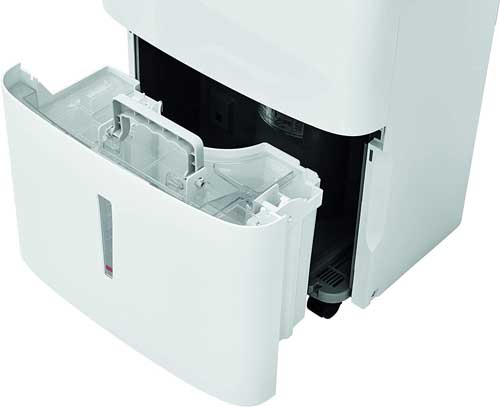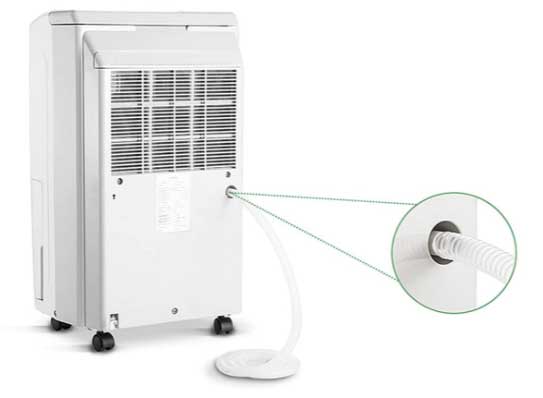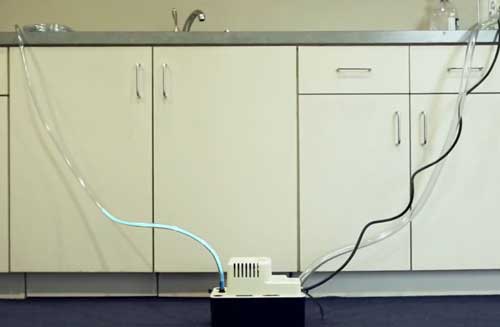Excess humidity is definitely an issues, explaining why dehumidifiers are rapidly gaining popularity. However, drainage is a common topic among dehumidifier users, with most people wondering what to do with the water collected by their moisture extractors.
There are three ways of draining your unit to the outside:
- Manual Drainage
- Automatic Gravity Drainage
- Automatic Condensate Pumps
- Additional Dehumidifier Drainage Considerations
Manual Drainage
Most dehumidifiers come with an auto-shutoff feature; when the water tank in your unit reaches maximum capacity, the dehumidifier will automatically turn off to prevent an overflow. This feature averts damage to the surrounding furniture and flooring and the machine’s self-damage. For your appliance to continue operating, you will need to drain the water tank.

- Locate the bucket often situated on the lower part of your dehumidifier.
- Carefully remove the bucket and pour the water into a sink, bathtub, or toilet. You may also carry the tank to the outdoors and dispose of the water into the floor drain. Also, you could choose to water your flowerbed with the condensate.
- Clean the water bucket before reinstalling it back into the dehumidifier.
- Note: If the tank is not installed correctly, the dehumidifier will not operate. You may also need to repeat the drainage process several times a day, depending on your unit’s reservoir size.
Automatic Gravity Drainage
Some dehumidifiers support the gravity method of discharging the condensate. These units feature a drain port that allows you to connect a hose and use gravity to drain the water automatically. This option is low-cost, and you should take advantage of it if your unit and home meet the basic requirements.

Automatic gravity drainage will eliminate the need to carry the water bucket up the stairs to your bathtub or across the room to a laundry sink or corner drain. With this drainage option, you have one less maintenance chore for your dehumidifier.
- Locate a drain port at the back or side of your dehumidifier
- Use a screwdriver to remove the plug that connects to your appliance
- Attach a drainage hose
Tip: Most dehumidifiers lack a drainage pipe in the purchase package. But don’t fret; if your unit doesn’t come with a tube, you may use a standard garden hose.
You’ll Need a Floor Drain
The continuous drainage method relies on gravity to discharge the condensate to your designated location. This implies that one end of the hose must be placed into a floor drain or any other site below the drain port.
Consider Raising Your Unit
If your home lacks a floor drain, you can improvise by placing your unit on a large, flat surface. Ideally, use a large table, concrete block, wooden skid, or anything capable of holding the weight of your dehumidifier. Ensure that your unit is level and check to see that it’s draining correctly.
Automatic Condensate Pumps
A condensate pump offers an excellent drainage option if your home lacks a floor drain. The pump channels the condensate through pipes to an elevated drainage point. Such include a sink, toilet, or tub, or even to the outdoors through a window. This is the most hassle-free method of draining your dehumidifier to the outside.
There are two types of condensate pumps:
- External Condensate Pump
- Internal Condensate Pump
External Condensate Pump
If your unit lacks a built-in condensate pump, you may purchase an external pump and take advantage of assisted drainage:
- Attach a hose to the drain port on your unit
- Connect the other end of the pipe to the external condensate pump
- Switch on both the condensate pump and the dehumidifier
Once the collected water fills the bucket, a float switch will trigger the pumping process. Direct the pumped water outside to a selected location, such as a water fountain. The condensate water pump can push water vertically or horizontally.
You could use this drainage option for your basement dehumidifier; the pump can push water 15 feet upwards. With this drainage option, you may effortlessly discharge the condensate through your basement’s door or window and direct it to your garden or walkway.

External Pump (Can be purchased separately used for pumping water)
Internal Condensate Pump
Some dehumidifiers come with a built-in condensate pump. These units also come with a drain hose designed for your specific model; you shouldn’t use any other pipe.
- Attach the provided drain hose to your unit
- Direct the other end of the pipe to your designated drainage location
An internal pump pushes the collected water out of the unit automatically, either vertically or horizontally, over long distances. Dehumidifiers with an integrated pump are commonly used in crawl spaces, attics, and basements since people rarely visit these areas.
Additional Dehumidifier Drainage Considerations
Making Use of the Collected Water
What to do with the condensate is a common question among dehumidifier users. You can use this water to clean your car, windows, and floors. However, drinking this water is not recommended.
Dealing with Leakages
You can use a leak detector to get notifications on your phone or tablet when there’s a leakage in the drain hose. A leak detector will come in handy when using a dehumidifier in spaces you don’t frequent, such as crawl spaces, basements, and boats.
Don’t Extend the Drain Hose
Most dehumidifier manufacturers warn against extending the drain hose. Prolonging the pipe could void your warranty or create leakage issues.
How Far Can You Drain the Condensate
Your external pump or dehumidifier’s manual provides vital information regarding how far the pump can push water, among other guidelines included in the purchase package. Most units with a built-in internal pump push the condensate 15 feet horizontally or vertically. Always check your unit’s manual before setting up the drainage system to be on the safe side.
The Bottom Line
A dehumidifier is used for extracting excess moisture from the indoor environment. These units go a long way in preventing dampness-related issues like furniture damage, foul odors, and health problems such as asthma and allergies. Nonetheless, people still refrain from using moisture extractors because of the hassle involved in emptying the condensate tank.
However, the benefits to your property, air quality and healthy should be persuasive enough to run your unit. Besides, you may find draining your unit as easy as pie with the above water removal options. You can take advantage of gravity drainage or a condensate pump to discharge the condensate outside to your flower garden, yard, walkway, or floor drain.
